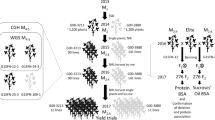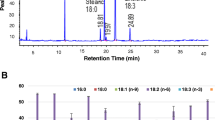Abstract
Unlike other oilseeds, soybean (Glycine max [L.] Merr) is also valuable due to its direct conversion into human food. One notable example is the cheese-like product tofu. The quality of tofu is improved when protein subunits derived from two glycinin genes, Gy1 and Gy4, are reduced or absent. Here we report the discovery that one exotic soybean plant introduction line, PI 605781 B, has not only a previously described loss-of-expression mutation affecting one glycinin gene (gy4), but also bears an extremely rare, potentially unique, frameshift mutation in the Glycinin1 gene (gy1-a). We analyzed glycinin gene expression via qRT-PCR with mRNA from developing seeds, which revealed that the novel allele dramatically reduced Gy1 mRNA accumulation. Similarly, both A4A5B3 and A1aB1a protein subunits were absent or at undetectable levels, as determined by two-dimensional protein fractionation. Despite the reduction in glycinin content, overall seed protein levels were unaffected. The novel gy1-a allele was found to be unique to PI 605871B in a sampling of 247 diverse germplasm lines drawn from a variety of geographic origins.





Similar content being viewed by others
References
Beilinson V, Chen Z, Shoemaker RC, Fischer RL, Goldberg RB, Nielsen NC (2002) Genomic organization of glycinin genes in soybean. Theor Appl Genet 104(6–7):1132–1140
Bilyeu KD, Zeng P, Coello P, Zhang ZJ, Krishnan HB, Bailey A, Beuselinck PR, Polacco JC (2008) Quantitative conversion of phytate to inorganic phosphorus in soybean seeds expressing a bacterial phytase. Plant Physiol 146(2):468–477
Bilyeu K, Gillman JD, LeRoy AR (2011) Novel FAD3 mutant allele combinations produce soybeans containing 1% linolenic acid in the seed oil. Crop Sci 51(1):1–5
Boland MJ, Rae AN, Vereijken JM, Meuwissen MPM, Fischer ARH, van Boekel MAJS, Rutherfurd SM, Gruppen H, Moughan PJ, Hendriks WH (2013) The future supply of animal-derived protein for human consumption. Trends Food Sci Technol 29(1):62–73
Chang Y-F, Imam JS, Wilkinson MF (2007) The nonsense-mediated decay RNA surveillance pathway. Annu Rev Biochem 76:51–74
Cho TJ, Davies CS, Fischer RL, Turner NE, Goldberg RB, Nielsen NC (1989a) Molecular characterization of an aberrant allele for the Gy3 glycinin gene: a chromosomal rearrangement. Plant Cell 1(3):339–350
Cho TJ, Davies CS, Nielsen NC (1989b) Inheritance and organization of glycinin genes in soybean. Plant Cell 1(3):329–337
Derbyshire E, Wright D, Boulter D (1976) Legumin and vicilin, storage proteins of legume seed. Phytochemistry 15(1):3–24
Gillman JD, Baxter I, Bilyeu K (2013) Phosphorus partitioning of soybean lines containing different mutant alleles of two soybean seed-specific adenosine triphosphate-binding cassette phytic acid transporter paralogs. Plant Genome 6(1):1–10
Gizlice Z, Carter TE Jr, Burton JW (1994) Genetic base for North American public soybean cultivars released between 1947 and 1988. Crop Sci 34(5):1143–1151
Gizlice Z, Carter TE Jr, Gerig TM, Burton JW (1996) Genetic diversity patterns in North American public Soybean cultivars based on coefficient of parentage. Crop Sci 36(3):753–765
Jegadeesan S, Yu K, Woodrow L, Wang Y, Shi C, Poysa V (2012) Molecular analysis of glycinin genes in soybean mutants for development of gene-specific markers. Theor Appl Genet 124(2):365–372
Jenkinson JE, Fehr WR (2010) Agronomic and seed characteristics of soybean lines with alleles for modified glycinin concentration. Crop Sci 50(5):1896–1903
Kim W-S, Ho HJ, Nelson RL, Krishnan HB (2008) Identification of several gy4 nulls from the USDA soybean germplasm collection provides new genetic resources for the development of high-quality tofu cultivars. J Agric Food Chem 56(23):11320–11326
Kinney AJ, Jung R, Herman EM (2001) Cosuppression of the α subunits of β-conglycinin in transgenic soybean seeds induces the formation of endoplasmic reticulum-derived protein bodies. Plant Cell 13(5):1165–1178
Kitamura K, Takagi T, Shibasaki K (1976) Subunit structure of soybean 11S globulin. Agric Biol Chem Tokyo 40(9):1837–1844
Krishnan HB, Natarajan SS, Mahmoud AA, Nelson RL (2007) Identification of glycinin and beta-conglycinin subunits that contribute to the increased protein content of high-protein soybean lines. J Agric Food Chem 55(5):1839–1845
Lam H-M, Xu X, Liu X, Chen W, Yang G, Wong F-L, Li M-W, He W, Qin N, Wang B, Li J, Jian M, Wang J, Shao G, Wang J, Sun SS-M, Zhang G (2010) Resequencing of 31 wild and cultivated soybean genomes identifies patterns of genetic diversity and selection. Nat Genet 42(12):1053–1059
Li C, Zhang YM (2011) Molecular evolution of glycinin and beta-conglycinin gene families in soybean (Glycine max L. Merr.). Heredity 106(4):633–641
Libault M, Thibivilliers S, Bilgin DD, Radwan O, Benitez M, Clough SJ, Stacey G (2008) Identification of four soybean reference genes for gene expression normalization. Plant Gen 1(1):44–54
Livak KJ, Schmittgen TD (2001) Analysis of relative gene expression data using real-time quantitative PCR and the 2-ΔΔCT method. Methods 25(4):402–408
Mahmoud AA, Natarajan SS, Bennett JO, Mawhinney TP, Wiebold WJ, Krishnan HB (2006) Effect of six decades of selective breeding on soybean protein composition and quality: a biochemical and molecular analysis. J Agric Food Chem 54(11):3916–3922
Peltz SW, Brown AH, Jacobson A (1993) mRNA destabilization triggered by premature translational termination depends on at least three cis-acting sequence elements and one trans-acting factor. Genes Dev 7(9):1737–1754
Pieretti MM, Chung D, Pacenza R, Slotkin T, Sicherer SH (2009) Audit of manufactured products: use of allergen advisory labels and identification of labeling ambiguities. J Allergy Clin Immun 124(2):337–341
Poysa V, Woodrow L, Yu K (2006) Effect of soy protein subunit composition on tofu quality. Food Res Int 39(3):309–317
Samuels ML, Witmer JA (1999) Statistics for the life sciences, 2nd edn. Prentice-Hall, London
Scallon BJ, Dickinson CD, Nielsen NC (1987) Characterization of a null-allele for the Gy4 glycinin gene from soybean. Mol Gen Genet 208(1):107–113
Schmidt MA, Barbazuk WB, Sandford M, May G, Song Z, Zhou W, Nikolau BJ, Herman EM (2011) Silencing of soybean seed storage proteins results in a rebalanced protein composition preserving seed protein content without major collateral changes in the metabolome and transcriptome. Plant Physiol 156(1):330–345
Schmutz J, Cannon SB, Schlueter J, Ma J, Mitros T, Nelson W (2010) Genome sequence of the palaeopolyploid soybean. Nature 463:178–183
Severin A, Woody J, Bolon Y-T, Joseph B, Diers B, Farmer A, Muehlbauer G, Nelson R, Grant D, Specht J, Graham M, Cannon S, May G, Vance C, Shoemaker R (2010) RNA-Seq Atlas of Glycine max: a guide to the soybean transcriptome. BMC Plant Biol 10(1):160
Takahashi K, Banba H, Kikuchi A, Ito M, Nakamura S (1994) An induced mutant line lacking the α-subunit of β-conglycinin in soybean (Glycine max (L.) Merrill). Jpn J Breed 44(1):65–66
Takahashi M, Uematsu Y, Kashiwaba K, Yagasaki K, Hajika M, Matsunaga R, Komatsu K, Ishimoto M (2003) Accumulation of high levels of free amino acids in soybean seeds through integration of mutations conferring seed protein deficiency. Planta 217(4):577–586
Thanh V, Shibasaki K (1978) Major proteins of soybean seeds: subunit structure of β-conglycinin. J Agric Food Chem 26(3):692–695
Yagasaki K, Kalzuma N, Kitamura K (1996) Inheritance of glycinin subunits and characterization of glycinin molecules lacking the subunits in soybean (Glycine max (L.) Merr.). Jpn J Breed 46(1):11–15
Acknowledgments
The authors would like to acknowledge the superb technical assistance of Sungchan Jang, Jeremy Mullis and Nathan Oehrle. This research was supported by the USDA-Agricultural Research Service.
Author information
Authors and Affiliations
Corresponding author
Additional information
Won-Seok Kim and Jason D. Gillman contributed equally to this work.
Mention of a trademark, vendor, or proprietary product does not constitute a guarantee or warranty of the product by the USDA and does not imply its approval to the exclusion of other products or vendors that may also be suitable.
Electronic supplementary material
Below is the link to the electronic supplementary material.
Supplementary Figure 1
Typical genotyping “melting peak” analyses for Gy1 and Gy4 SimpleProbes. Colors: Light blue line indicates negative control, dark blue indicates homozygote mutant, red indicates homozygote wild type, green indicates heterozygote. Analysis was run on a Lightcycler 480 II (Roche). (PPTX 153 kb)
Supplementary Figure 2
One dimensional protein gel electrophoresis of lines selected via genotyping assays. 40 micrograms of seed protein were separated on 12.5 % SDS-PAGE gels. C indicates protein from ‘Patriot’ seeds and PI indicates protein from PI 605871 B seeds, numbered samples were F2:3 seeds from F2 selections for gy4 or Gy4 homozygotes identified by SimpleProbe assay (genotype is indicated at bottom of chart). * indicates either A4 or B5 glycinin subunit, encoded by the Gy4 gene. (PPTX 351 kb)
Supplemental Table 1
Glycinin primers used in this work (XLSX 12 kb)
Supplemental Table 2
Distribution of Gy1 alleles in a diverse sampling of 247 genotypes (XLSX 32 kb)
Rights and permissions
About this article
Cite this article
Kim, WS., Gillman, J.D. & Krishnan, H.B. Identification of a plant introduction soybean line with genetic lesions affecting two distinct glycinin subunits and evaluation of impacts on protein content and composition. Mol Breeding 32, 291–298 (2013). https://doi.org/10.1007/s11032-013-9870-8
Received:
Accepted:
Published:
Issue Date:
DOI: https://doi.org/10.1007/s11032-013-9870-8




